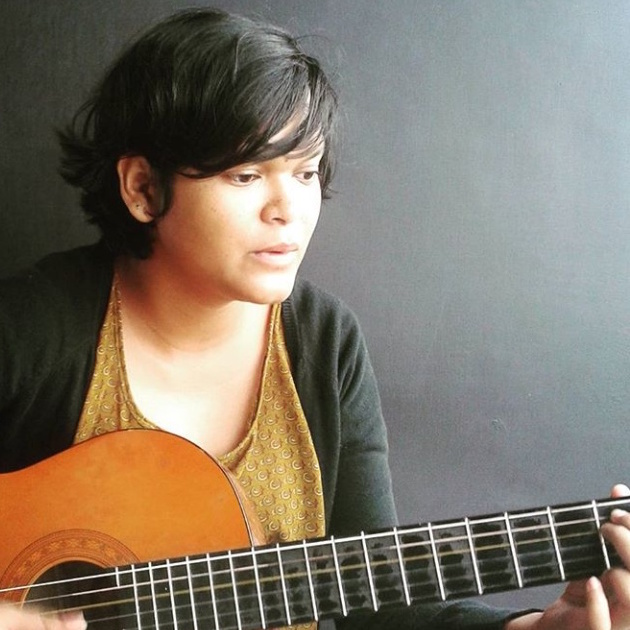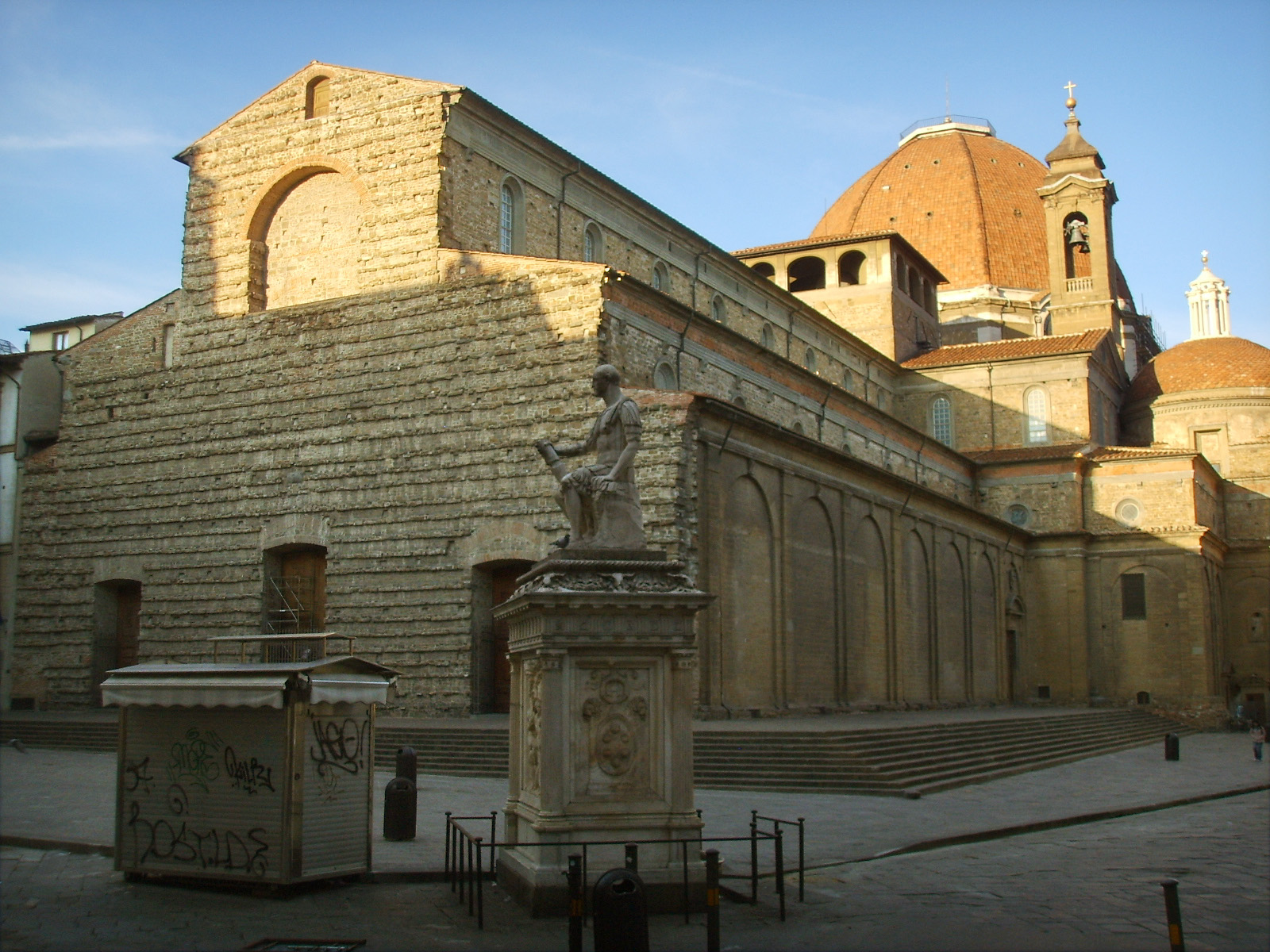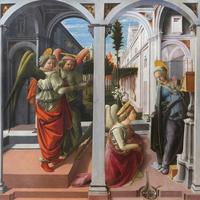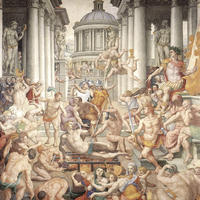More about Basilica di San Lorenzo
Works at Basilica di San Lorenzo

Contributor
If you were extremely ambitious, and you decided to undertake a study of the narrative origins of Christianity as a sect within the ancient Roman empire, the Basilica of San Lorenzo could be a good point of departure.
Local tradition claims that it was consecrated by Ambrose over 1,600 years ago. However, the building of today was constructed just around 650 years ago by Brunelleschi, and the Medici family, for whom the building served as both crypt and home church, was responsible for its maintenance and restoration during that period. Lively debates continue as to the dating of the various parts of the Basilica, as several generations of prominent architects and artists, including Donatello and Michelangelo, have added their own elements to the Basilica, creating a multilayered and nuanced environment with many open questions.
"The exterior of the building...does not correspond to the interior," and "there is disagreement among scholars about the dating of the crypts beneath the chapel." Stakes of the controversy are high, as researchers in architecture, archaeology, sculpture, painting and other fields weigh in on issues of chronology and authorship, such as the question of whether Michelangelo built the new sacristy de novo, i.e. "from scratch," or whether he used an earlier artifice and/or design as a model.
The Basilica's Laurentian library features a staircase designed by Michelangelo, and the library itself contains the Medici collection of more than 11,000 manuscripts, including works by Pliny, Sophocles, and the vegetarian Platonist Ficino.
For the Medicis and other patrons of the Renaissance, science and mathematics were "natural philosophy," and, as for the Greeks and Romans, the exact sciences had an essential and inherent connection to artistic practices. Both everyday people and intellectuals, for example, saw no direct conflict between metaphysics and physics, or between music and philosophy. The Museo Galileo writes, of Brunelleschi's architecture, "According to recent studies that have made it possible to date the astral conjunction depicted, though leaving the matter of its motive undetermined, [the]...small planetarium, based on geocentric concepts of Ptolemaic origin, probably reproduces the sky of Florence in July 1442." Although, with characteristic ignorance, patrons restricted sponsorship of such investigations to "Renaissance men," European men of a certain pedigree, the patrons made possible a degree of interdisciplinary investigation which contributed enormously to culture, architecture, policy and literature.
Sources
- Basilica of San Lorenzo," Museo Galileo, https://brunelleschi.imss.fi.it/itineraries/place/BasilicaOfSanLorenzo….
- Cohen, Matthew A. "How Much Brunelleschi? A Late Medieval Proportional System in the Basilica of San Lorenzo in Florence." Journal of the Society of Architectural Historians 67, No. 1 (March 2008):18-57.
- Morrow, Johnica J., Allen Myhra, Dario Piombino-Mascali, Donatella Lippi, Amanda Roe, Leon Higley, and Karl J. Reinhard. "Archaeoentomological and archaeoacarological investigations of embalming jar contents from the San Lorenzo Basilica in Florence, Ital
- Reiss, Sheryl E. "The Ginori Corridor of San Lorenzo and the Building History of the New Sacristy." JSAH 52 (Sep. 1993): 339-343.
- Santi, Bruno. San Lorenzo: a Guide to the Laurentian Complex. Firenze: Becocci/Scala, 1992.
- Vaughn, Samantha. "San Lorenzo Church in Florence: A Short Guide." The Florentine, Sep. 19, 2018, http://www.theflorentine.net/art-culture/2018/09/san-lorenzo/.

Contributor
One section of the Basilica of San Lorenzo belongs to the biggest, baddest family in all of Florence: The Medicis.
The Medici Chapel comprises two structures, the New Sacristy designed by Michelangelo, and the Chapel of the Princes which was a collaborative exercise. The Grand Dukes lie, unclaimed by both heaven and hell, in the crypt right below the Chapel of Princes. The new sacristy was initially supposed to hold four dead Medicis, but Michelangelo was able to build only two tombs for Lorenzo and Guiliano Medici, Dukes of Urbino and Nemour, respectively.
We knew they were rich, but when you see the Medici Chapel you realize that even the Medicis couldn’t buy their way into heaven. They had popes, clergymen, dukes, they were both kings and gods. But they still couldn’t find a way in. Look at all the gold they weren’t able to carry. It’s like the guards at the gates of hell found the gold and told them that they could only take enough for one bribe. So they left the rest on Earth and now they are being tortured and will be tortured, for the rest of time. How cool is that?
The Medici Chapel was a rush job. The construction of the New Sacristy was halted when Michelangelo publically opposed the Medici rule. He had to go into hiding for a few months, though he didn't go far, because when Pope Clement VII announced that all would be forgiven, Michelangelo crawled right out. He was in fact very, very close by. In 1976, a secret room was discovered under the New Sacristy. It was full of drawings, Michelangelo’s drawings. He hid right under their noses and they never got to know. The secret room is not always open to the public, but we recommend you ask the museum, you might just get lucky. The New Sacristy was ultimately finished by Michelangelo’s friends Giorgio Vasari and Bartolomeo Ammannati in 1555.
The Chapel of the Princes had a lot of cooks stirring the pot. The Grand Duke’s son Giovanni de Medici made the initial sketches for the Chapel, Bernardo Buontalenti revised the sketches, and Nigetti Matteo spent 40 years of his life building the thing. The Medicis wanted to fill the walls with lapis lazuli. Unfortunately, their fall from power stopped that from happening. The Chapel of the Princes should’ve been ready in 1640. Instead, the Lorraine family (the next gangster family of Italy) had to call in Pietro Benevuneti to complete the frescoes. That was in 1828. The inlay of fancy gemstones wasn't installed until 1962. The Medici Chapel was a very slow long con. It took forever to be built and probably didn't get anyone into heaven.
Sources
- "Medici Chapels and Church of San Lorenzo." Florence. Accessed August 01, 2019. http://www.museumsinflorence.com/musei/Medici_chapels.html.
- Elam, Caroline. "The Site and Early Building History of Michelangelo's New Sacristy." Mitteilungen Des Kunsthistorischen Institutes in Florenz 23, no. 1/2 (1979): 155-86. http://www.jstor.org/stable/27652473.
- Ugc. "Michelangelo's Hidden Drawings." Atlas Obscura. September 20, 2016. Accessed August 01, 2019. https://www.atlasobscura.com/places/michelangelos-hidden-drawings.
- "Medici Chapels in Florence." The Florentine. January 11, 2019. Accessed August 01, 2019. http://www.theflorentine.net/art-culture/2019/01/medici-chapels/.
- "The Medici Chapels - Florence, San Lorenzo Church." Florence Inferno. June 20, 2019. Accessed August 01, 2019. https://www.florenceinferno.com/medici-chapels/
Featured Content
Here is what Wikipedia says about Basilica of San Lorenzo, Florence

The Basilica di San Lorenzo (Basilica of St. Lawrence) is one of the largest churches of Florence, Italy, situated at the centre of the main market district of the city, and it is the burial place of all the principal members of the Medici family from Cosimo il Vecchio to Cosimo III. It is one of several churches that claim to be the oldest in Florence, having been consecrated in 393 AD, at which time it stood outside the city walls. For three hundred years it was the city's cathedral, before the official seat of the bishop was transferred to Santa Reparata.
San Lorenzo was the parish church of the Medici family. In 1419, Giovanni di Bicci de' Medici offered to finance a new church to replace an eleventh-century Romanesque rebuilding. Filippo Brunelleschi, the leading Renaissance architect of the first half of the fifteenth century, was commissioned to design it, but the building, with alterations, was not completed until after his death. The church is part of a larger monastic complex that contains other important architectural and artistic works: the Old Sacristy ("Sagresta Vecchia") by Brunelleschi and having interior decoration and sculpture by Donatello; the Laurentian Library by Michelangelo; the Medici Chapels, two structures that include the New Sacristy ("Sagrestia Nuova") based on Michelangelo's designs; and the larger Cappella dei Principi ("Chapel of the Princes") being a collaboration between the family and architects.
Check out the full Wikipedia article about Basilica of San Lorenzo, Florence












